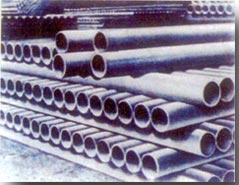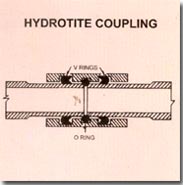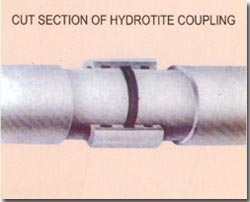|
 |
|
|
|
|
|
|
A.C. Pressure Pipes :- |
|
|
Hari AC Pressure Pipes are made from
a careful blend of imported Asbestos Fiber generally imported from
Canada & Russia, and high quality cement. Hari Pressure Pipes are
manufactured on highly sophisticated and modern machines by skilled
personnel. |
|
Stringent quality control procedures
at various stages ensure a consistently high standard product which
even exceeds Is specifications. |
|
Fibre Reinforcement :- The manufacture
of Asbestos Cement Pressure Pipes exploits to the full, the strength
, flexibility and indestructibility of the Asbestos Fibres. These
fibers provide the reinforcement for the cement, the two materials
make the perfect bond. The raw material is carefully processed and
mixed by wet process which ensures uniform high quality of pipes.
|
|
Easy to join easy to remove :- Hari
Industries
offers both CID joints and AC coupling for easy installation. Both
these types of joints offer flexibility and ensure watertightness. |
|
Certificate of Performance :- Hari
Pressure Pipes are stamped with ISI mark as per IS : 1592 promising
reliable performance and genuine long term economy. Our list of
clients include various Govt. Departments all over the country,
public and private undertakings. |
|
USES :- AC Pressure Pipes enjoy
multiple uses including the following
-
Agriculture
-
Irrigation
-
Lift Irrigation
-
Municipalities
-
Projects and colonies works with
contractors.
-
Public Health Departments of various
States.
-
Water Supply and sewage schemes.
-
Under drainage of lined canals
|
|
How to Store :- |
|
Pipe must be stacked
properly as shown, to avoid damage. The width and depth of the
trench works should be as recommended in the diagram. The excavated
soil should be dumped on the traffic side of the trench to form a
protection. Space of about 0.5 meter should be left along the trench
for workmen to move freely. |
 |
|
Product Facts :- Hari AC
Pressure pipes have a standard length of 4m. They are available in
nominal Diameters of 80, 100, 125, 150, 200, 250 & 300 mm in Classes
10, 15 & 20. |
| |
|
Coupling and Joints :- |
|
 |
Hari AC Pressure Pipes can easily be
joined together with AC Hydrotite Coupling or Cast Iron Detachable
Joints. |
| |
| Hari AC
Hydrotite Coupling :- |
|
Hari Hydrotite Joint Consists of a
precision machined AC Hydrotite Coupling with three innner grooves
fitted with one rubber 'O' ring in the centre and two scientifically
designed rubber 'V' rings on either side. The 'O' ting ensures
separation of the two pipes in the coupling and allows flexibility.
The 'V' rings combine the principle of compression and hydrostatic
sealing to ensure watertightness. |
 |
| |
|
Laying and jointing of Pipes :- |
|
|
-
Clean the pipe ends the components
of CID joints. The CID joint comprises a central collar, two
flanges , two round rubber rings, bolts and nuts. The two rubber
rings placed on the pipe ends and copressed between collar and
flange , by means of steel bolts provide the necessary sealing.
Since rubber rings for pipes of diameters 150 mm and below cannot
be placed on the pipes by stretching, an AC or wooden cone
may be used for this purpose.When placed by the above method, the
rubber ring will not be in the correct position. Hence it is
essential to make a site gauge as illustrated n the figure and the
ring is brought to the correct position.
|
-
Insert the flanges on pipe ends.
With the help of wooden cone place the rubber rings on pipe
ends and roll them to the correct position.
-
Place the central collar of the laid
pipe close to the pipe to be joined . Centralise the collar,
leaving a gap of about 5mm between the pipe ends.
-
Now position the rings to touch the
collar end. Move the flanges close. Insert bolts in the flange
holes and tighten them. The bolts should be tightened uniformly to
ensure a leak proof joint.
-
After testing the pipeline , the
trench should be filled up.
|
|
Note :- We can also provide ISI marked
C.I. Detachable Joints, C.I. P/E Specials, C.I.D/F Fittings & Pipes. |
| |
|
S.L. No. |
NOM Dia.
(mm) |
Class - 10 |
Class - 15 |
Thickness
(mm) |
External Dia
(mm) |
Thickness
(mm) |
External Dia
(mm) |
|
i |
80 |
9.5 |
99.5 |
9.5 |
99.5 |
|
ii |
100 |
9.5 |
120.0 |
10.0 |
121.0 |
|
iii |
125 |
9.5 |
145.0 |
11.0 |
147.0 |
|
iv |
150 |
9.5 |
171.0 |
13.0 |
176.5 |
|
v |
200 |
11.5 |
225.0 |
16.5 |
233.5 |
|
vi |
250 |
12.0 |
276.5 |
17.0 |
284.5 |
|
vii |
300 |
14.0 |
328.5 |
20.0 |
340.5 |
|
|
Tests and specifications :- |
|
Hari A.C. Pressure pipe are
manufactured and tested for strict conformity to Is 1592/89 G.G.
Pipes Pvt. Ltd., Kaladera, Jaipur have got a sophisticated
laboratory with the most modern equipment for testing A.C. Pressure
pipes. |
| 1.
Hydradraulic Pressure Tightness Test :- |
| Every
pipe is tested to he pressure corresponding to the class of pipe as
given below : |
| |
|
Class of Pipe |
Test Pressure in Kg./cm2 |
Max. recommended
Working Pressure Kg./cm2 |
|
10 |
10 |
5.0 |
|
15 |
15 |
7.5 |
|
20 |
20 |
10 |
|
| |
| The pipe
is placed in a hydraulic press and the hydraulic pressure inside the
pipe is progressively increased to the specified value and
maintained for a minimum of 30 seconds. Pipes should not indicate
any sweating on the outside. |
| |
| 2.
Hydraulic Bursting Test :- Hari Pressure pipe are tested to satisfy
a minimum unit bursting stress of 20 N/mm2 for sizes upto and
including 300 mm diameter. |
| |
| 3.
Transverse Curshing Stress :- The unit Transverse crushing stress
arrived at from transverse crushing test shall not be less than 44
N/mm2. |
| |
|
4. Longiudinal Bending Test :- The
unit longitudinal bending stress arrived at from longitudinal
bending test shall not be less than 24.5N/mm2. Only pipes of
150mm dia and less are tested for longitudinal bending strength
increases considerably as the section modules increases and
therefore need not be separately considered. |
| |
|
5. Hari A.C. Pressure Pipes also
satisfy the following ratios between Bursting Pressures (BP),
Hydraulic Test Pressures (TP) and Normal Hydraulic Working Pressures
(WP) |
| |
|
Nominal Dia. |
BP/TP |
BP/WP |
|
80 and 100 |
2.00 |
4.0 |
|
125 to 200 |
1.75 |
3.5 |
|
250 to 300 |
1.50 |
3.0 |
|
| |
| |
|
 |
| |
| |
| |
| |